Physical Address
304 North Cardinal St.
Dorchester Center, MA 02124
Physical Address
304 North Cardinal St.
Dorchester Center, MA 02124
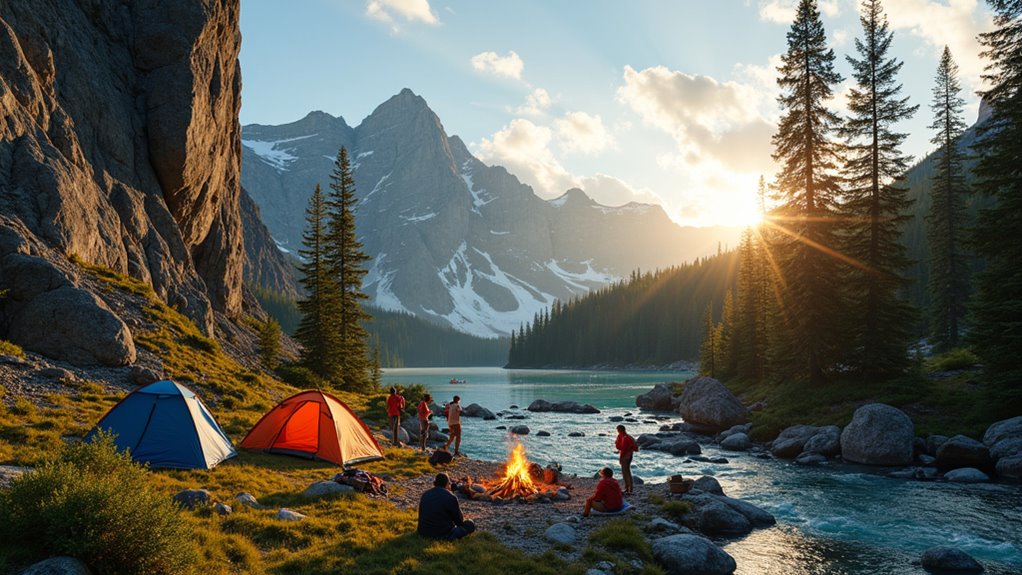
Camping adventures await beyond basic hiking—discover 15 heart-pounding activities that will completely transform your ordinary outdoor trips into unforgettable expeditions.
You’ll be surprised to learn that over 77 million Americans went camping in 2022, yet most stuck to basic activities like hiking and fishing. If you’re ready to elevate your outdoor experience beyond the ordinary, there’s a world of heart-pounding adventures waiting at your next campsite. From scaling vertical rock faces to traversing underground cave systems, these adrenaline-fueled activities will transform your typical camping trip into an unforgettable expedition that challenges every limit you thought you had.
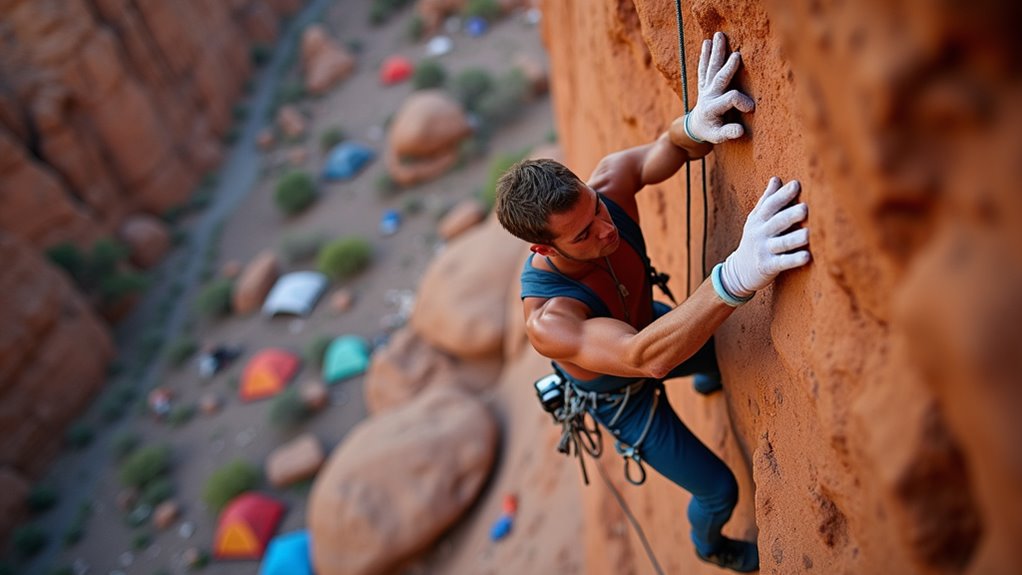
Why settle for admiring towering rock faces from afar when you can scale them yourself? Rock climbing and bouldering transform your camping trip into an adrenaline-fueled adventure that’ll test your physical and mental limits.
Start with bouldering if you’re new to vertical challenges. These shorter climbs don’t require ropes, making them perfect for beginners. You’ll only need climbing shoes, chalk, and a crash pad for safety.
Bouldering offers the perfect introduction to climbing – no ropes needed, just shoes, chalk, and a crash pad for protection.
Ready for bigger walls? Traditional rock climbing opens up endless possibilities. You’ll need harnesses, ropes, helmets, and proper anchoring gear. Always climb with experienced partners and check local regulations before scaling any rock face.
Both activities build incredible strength, problem-solving skills, and confidence. Research climbing areas near your campsite beforehand, and consider hiring local guides who know the best routes for your skill level.
Many climbers combine their rock adventures with hiking vacations to explore diverse terrain and discover hidden climbing gems in remote wilderness areas.
When’s the last time you felt your heart pound as rushing water carries you downstream through narrow canyon walls? Whitewater rafting and kayaking transform your camping trip into an adrenaline-fueled adventure that’ll leave you craving more.
These water sports offer varying difficulty levels, from gentle Class I rapids perfect for beginners to heart-stopping Class V torrents for experts. You’ll navigate through stunning landscapes while working as a team to conquer nature’s obstacles.
Essential gear includes:
Many camping destinations offer guided expeditions with professional instructors who’ll teach proper paddling techniques and safety protocols.
For those seeking even more extreme challenges, consider exploring glacier climbing opportunities in mountainous regions where frozen waterfalls and ice formations create spectacular vertical adventures.
You’ll return to camp exhausted but exhilarated, with unforgettable memories.
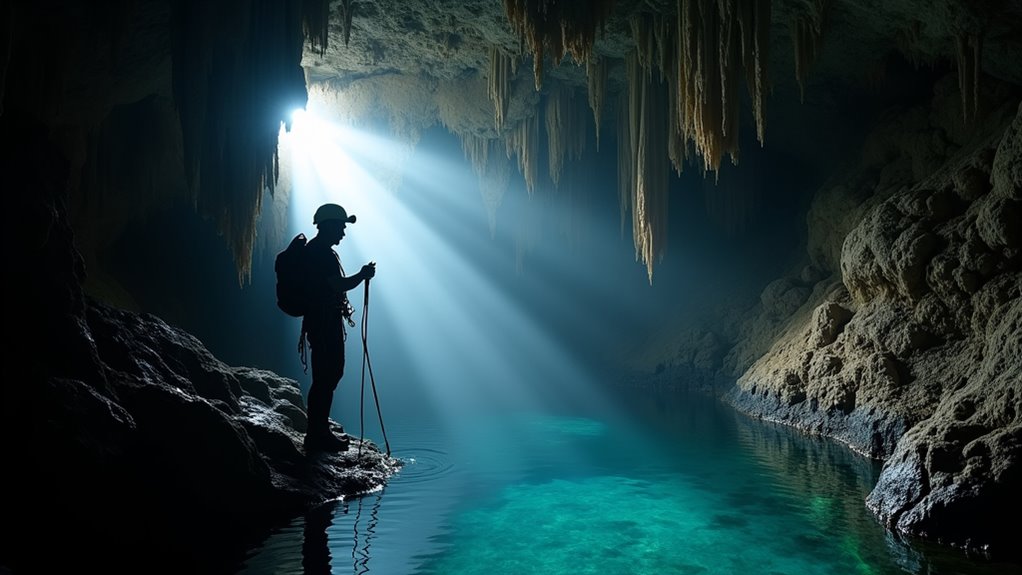
After conquering rushing rapids above ground, you might find yourself drawn to the mysterious world that exists beneath your feet. Cave exploration offers an entirely different camping adventure that’ll challenge your problem-solving skills and nerve.
You’ll need specialized gear including helmets with headlamps, sturdy gloves, and appropriate footwear with good grip. Start with guided tours at commercial caves before attempting wild cave systems. These underground journeys require physical fitness since you’ll be crawling, climbing, and squeezing through tight passages.
Safety’s paramount in spelunking. Always inform someone of your plans, carry backup lighting, and never explore alone. The reward? You’ll discover stunning rock formations, underground rivers, and chambers that few people ever see. It’s an unforgettable addition to any camping trip.
If you’re planning to combine spelunking with RV camping, research campgrounds near cave systems while avoiding common RV mistakes that could derail your underground adventure plans.
While cave exploration takes you deep underground, mountain biking launches you across rugged landscapes where every pedal stroke becomes an adventure. You’ll navigate rocky trails, steep climbs, and technical descents that test your skills and endurance.
The combination of physical challenge and stunning scenery makes mountain biking one of camping’s most rewarding activities.
Before hitting the trails, you’ll need proper preparation:
Start with easier trails to build confidence, then gradually tackle more challenging terrain. You’ll discover that mountain biking transforms your camping experience into an adrenaline-fueled journey through nature’s playground. After a full day of trail riding, a reliable lantern will help you navigate your campsite and prepare for another day of adventure.

Where mountain biking conquers horizontal distances, backcountry hiking conquers vertical ones through the challenging pursuit of peak bagging.
You’ll push your limits ascending steep trails, maneuvering rocky scrambles, and reaching summits that reward you with breathtaking panoramic views.
Peak bagging isn’t just hiking—it’s collecting mountain summits like trophies.
You’ll need proper gear: sturdy boots, trekking poles, layers for changing weather, and navigation tools.
Start with easier peaks to build endurance and technical skills before tackling challenging routes.
Plan your ascents carefully. Check weather conditions, inform others of your route, and start early to avoid afternoon storms.
The physical demands are intense, but standing atop a peak you’ve conquered delivers an unmatched sense of accomplishment that flat-ground adventures simply can’t provide.
For those introducing children to peak bagging, consider making it part of a family camping experience where everyone can enjoy the outdoors together at a comfortable pace.
From conquering peaks on foot, you can experience the forest from an entirely different perspective—soaring through treetops on ziplines that transform you from ground-bound hiker to high-speed aerial adventurer.
Zip lining offers adrenaline-pumping thrills while showcasing panoramic views you’d never glimpse from traditional trails. You’ll race between platforms suspended hundreds of feet above ground, feeling wind rush past as you glide through canopies at speeds reaching 50+ mph.
Essential preparation includes:
Many adventure camps integrate zip lining with camping packages, letting you wake up and immediately launch into aerial excitement.
It’s perfect for campers seeking heart-pounding activities that showcase nature’s beauty from thrilling new heights. For those who prefer staying closer to ground level, winter camping in recreational vehicles provides a completely different but equally rewarding outdoor experience.

Why settle for admiring mountain lakes from shore when you can glide across their pristine surfaces on a paddleboard? Stand-up paddleboarding on alpine lakes delivers unmatched serenity while challenging your balance and core strength.
You’ll need a stable board designed for beginners, plus a proper wetsuit since mountain water stays cold year-round. Start on calm mornings when winds are minimal and practice basic strokes near shore before venturing deeper.
The payoff’s incredible – you’re literally walking on water surrounded by towering peaks and crystal-clear depths. Wildlife often approaches curious paddlers, from curious fish below to eagles soaring overhead.
Pack waterproof gear and always wear your leash. Mountain weather changes quickly, so monitor conditions constantly and stay close enough to shore for safe return. Many families bring their paddleboards along on RV camping trips to easily transport gear between different alpine destinations throughout the summer.
How can you experience the thrill of mountain climbing without years of technical training? Via ferrata routes offer the perfect solution. These “iron roads” feature fixed cables, ladders, and bridges anchored directly into rock faces, letting you tackle dramatic cliff routes safely with minimal experience.
Fixed cables and metal rungs transform intimidating cliff faces into thrilling adventures for climbers of all skill levels.
You’ll wear a specialized harness system with energy-absorbing lanyards that clip onto the steel cables. This setup provides continuous protection as you traverse exposed mountainsides, cross suspension bridges, and climb vertical sections that’d normally require advanced rock climbing skills.
Essential via ferrata gear includes:
Many mountain camping destinations now feature these routes, making high-altitude adventures accessible to adventurous beginners.
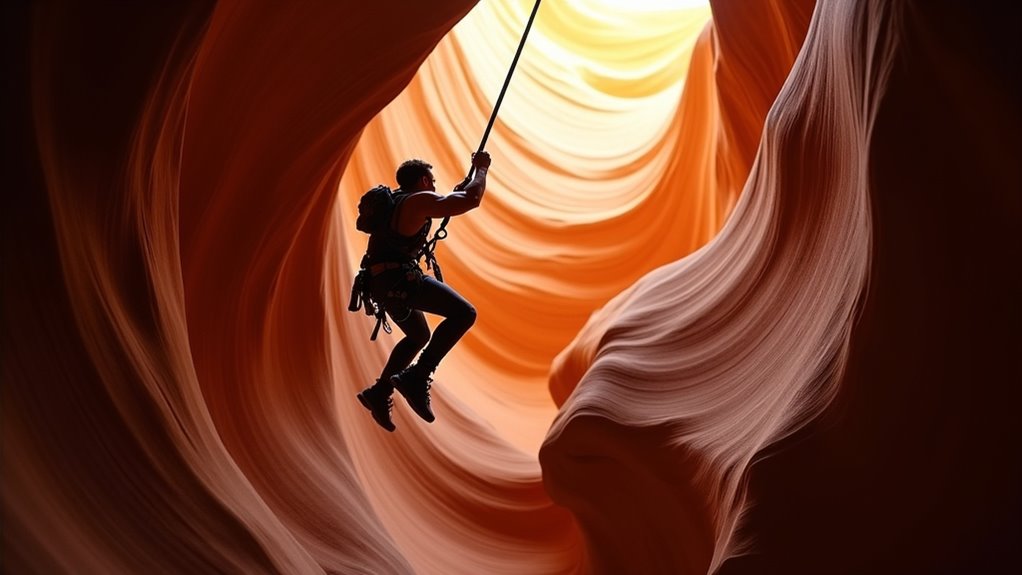
When towering canyon walls narrow to just arm’s width above your head, you’ll discover why canyoneering ranks among camping’s most exhilarating adventures. You’ll navigate through twisted passages, rappel down waterfalls, and squeeze through openings that test your nerve and flexibility.
Start with beginner-friendly slot canyons like Utah’s Antelope Canyon or Arizona’s Canyon X. You’ll need a helmet, harness, rappelling device, and waterproof gear since many routes involve wading through pools or streams.
Check weather conditions religiously – flash floods can turn narrow canyons deadly within minutes. Always inform someone of your planned route and expected return time.
The Southwest offers premier canyoneering destinations, but you’ll find exciting slots throughout rocky regions. Book guided trips initially to learn proper techniques and safety protocols before tackling routes independently.
While canyoneering through remote wilderness areas, understanding wild animal safety becomes crucial for protecting yourself during overnight camping portions of multi-day canyon expeditions.
What separates confident campers from anxious ones? It’s their ability to handle unexpected situations with practical skills rather than panic. Wilderness survival challenges aren’t about creating dangerous scenarios—they’re about building confidence through controlled practice of essential techniques.
Start with these fundamental skills:
You’ll transform camping anxiety into excitement when you know you can handle equipment failures or weather changes. Practice these skills during regular camping trips, not actual emergencies.
Start simple, progress gradually, and always inform others of your location. These challenges become rewarding confidence-builders that enhance every outdoor adventure. Before attempting advanced wilderness skills, master the basics of tent camping to ensure you have a solid foundation for outdoor adventures.

Once darkness falls over your campsite, the night sky transforms into nature’s most spectacular theater. You’ll discover photography opportunities that simply don’t exist in light-polluted cities. Start with basic stargazing—identify constellations using smartphone apps like Star Walk or SkyView.
For photography, you’ll need a tripod and camera capable of manual settings. Set your ISO between 1600-3200, open your aperture wide (f/2.8 or lower), and experiment with 15-30 second exposures.
Don’t forget lunar photography when there’s a bright moon. You can capture stunning silhouettes of trees against star-filled skies. Bring red-filtered flashlights to preserve your night vision while adjusting equipment.
Plan your shots during new moon phases for maximum star visibility, or embrace moonlit landscapes for dramatic contrast. If you’re camping near a lake or river, consider whether renting a boat for dawn photography sessions might offer unique water-level perspectives of your starlit shots reflected on the surface.
Why settle for crowded ski resorts when winter’s backcountry offers untouched powder and pristine wilderness? Backcountry skiing and snowshoeing transform your winter camping into an adrenaline-fueled adventure through nature’s frozen playground.
You’ll need proper gear and avalanche knowledge before venturing out. Start with snowshoeing if you’re new to winter backcountry – it’s easier to learn and requires less specialized equipment.
For skiing, touring skis with climbing skins let you ascend mountains under your own power.
Essential preparation includes:
Both activities offer incredible workouts while accessing remote winter landscapes that few people ever experience. When planning your winter backcountry adventure, remember that proper backpacking preparation ensures your comfort and safety during extended trips in harsh conditions.

While day climbing offers thrills, multi-pitch routes elevate your camping adventure to vertical expeditions that’ll test your skills across hundreds of feet of rock. You’ll need specialized gear: double ropes, extensive rack of protection, lightweight camping equipment, and emergency supplies. Planning’s essential—study route descriptions, weather patterns, and escape options before committing.
Multi-pitch climbing demands efficient systems. You’ll belay from anchors, manage rope tangles, and communicate across long distances.
Pack light but smart: bring headlamps for early starts or late finishes, extra layers for temperature changes at altitude, and sufficient water.
Your reward? Spectacular bivouac sites on ledges with unmatched views. Whether it’s El Capitan’s granite faces or international alpine routes, multi-pitch expeditions combine technical climbing with wilderness camping for unforgettable adventures. Master belaying techniques to ensure safety and efficiency when transitioning between pitches on these extended vertical journeys.
Finding your way back to camp after a day of vertical adventures brings us to one of camping’s most valuable skills: orienteering and navigation. You’ll discover that mastering these techniques transforms uncertainty into confidence during wilderness excursions.
Modern GPS devices are helpful, but they shouldn’t replace fundamental navigation skills. Practice reading topographic maps and using a compass before heading into challenging terrain. These analog tools won’t fail when batteries die or signals disappear.
Essential navigation skills include:
Start with day hikes near camp, gradually increasing difficulty. You’ll build spatial awareness while developing problem-solving abilities that’ll serve you throughout countless outdoor adventures.
Remember to maintain proper hydration during these navigation exercises, as intelligent water bottles like the Sportline Hydracoach can help monitor your fluid intake throughout extended outdoor activities.
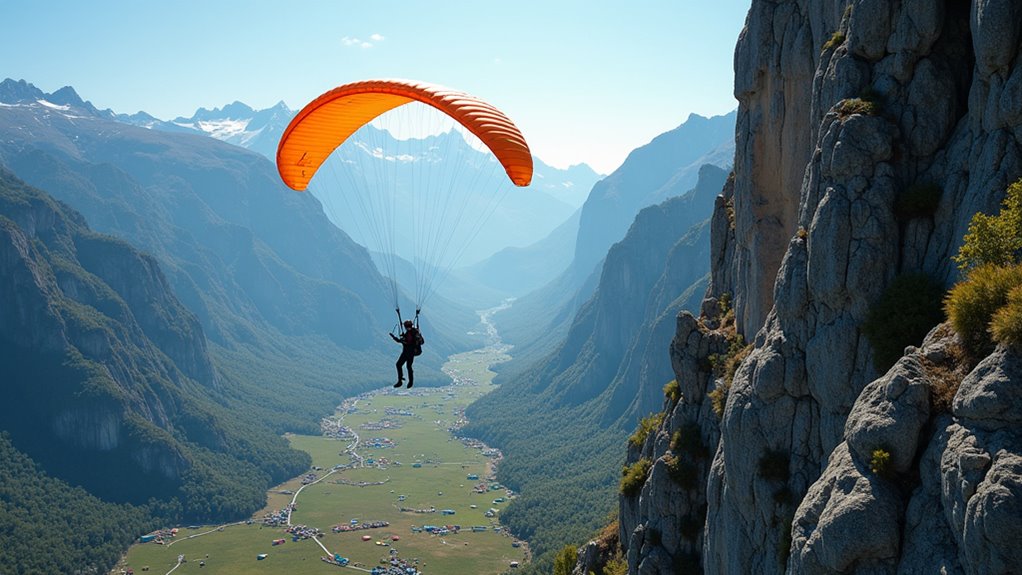
How do you take camping adventures to the ultimate extreme? Paragliding and base jumping from cliffs deliver unmatched adrenaline rushes that’ll redefine your outdoor experience.
You’ll need extensive training before attempting either activity. Paragliding requires certified instruction, proper equipment checks, and understanding wind patterns.
Proper training, certified instruction, and thorough equipment checks are absolutely essential before attempting any extreme aerial sports.
Base jumping demands even more preparation – it’s considered one of the world’s most dangerous sports.
Choose established jumping sites with safety records and experienced guides. Popular destinations include Interlaken, Switzerland, and Moab, Utah.
Always verify weather conditions and equipment functionality.
Don’t attempt these activities without proper certification and supervision. The thrill’s incredible, but safety must come first.
Start with tandem jumps to experience the rush before pursuing solo certification.
These extreme sports transform ordinary camping trips into unforgettable adventures that push your limits skyward. For those seeking challenging terrain to combine with extreme sports, Death Valley offers some of the most demanding hiking trails to test your skills before taking to the skies.
You’ll discover something remarkable happens when you push beyond your comfort zone in the wilderness—confidence naturally builds with each conquered peak and navigated rapid. It’s no coincidence that the most rewarding moments often come when you’re furthest from civilization, relying on your skills and instincts. These thrilling activities don’t just create unforgettable memories; they’ll transform how you see yourself and what you’re truly capable of achieving in life’s adventures.